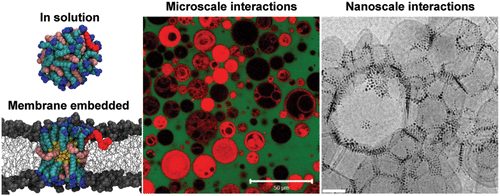当前位置:
X-MOL 学术
›
Bioconjugate Chem.
›
论文详情
Our official English website, www.x-mol.net, welcomes your
feedback! (Note: you will need to create a separate account there.)
Structure–Property Relationships of Amphiphilic Nanoparticles That Penetrate or Fuse Lipid Membranes
Bioconjugate Chemistry ( IF 4.0 ) Pub Date : 2018-02-21 00:00:00 , DOI: 10.1021/acs.bioconjchem.7b00777 Prabhani U Atukorale , Zekiye P Guven , Ahmet Bekdemir , Randy P Carney , Reid C Van Lehn , Dong Soo Yun , Paulo H Jacob Silva , Davide Demurtas , Yu-Sang Yang , Alfredo Alexander-Katz , Francesco Stellacci , Darrell J Irvine 1, 2
Bioconjugate Chemistry ( IF 4.0 ) Pub Date : 2018-02-21 00:00:00 , DOI: 10.1021/acs.bioconjchem.7b00777 Prabhani U Atukorale , Zekiye P Guven , Ahmet Bekdemir , Randy P Carney , Reid C Van Lehn , Dong Soo Yun , Paulo H Jacob Silva , Davide Demurtas , Yu-Sang Yang , Alfredo Alexander-Katz , Francesco Stellacci , Darrell J Irvine 1, 2
Affiliation

|
The development of synthetic nanomaterials that could embed within, penetrate, or induce fusion between membranes without permanent disruption would have great significance for biomedical applications. Here we describe structure–function relationships of highly water-soluble gold nanoparticles comprised of an ∼1.5–5 nm diameter metal core coated by an amphiphilic organic ligand shell, which exhibit membrane embedding and fusion activity mediated by the surface ligands. Using an environment-sensitive dye anchored within the ligand shell as a sensor of membrane embedding, we demonstrate that particles with core sizes of ∼2–3 nm are capable of embedding within and penetrating fluid bilayers. At the nanoscale, these particles also promote spontaneous fusion of liposomes or spontaneously embed within intact liposomal vesicles. These studies provide nanoparticle design and selection principles that could be used in drug delivery applications, as membrane stains, or for the creation of novel organic/inorganic nanomaterial self-assemblies.
中文翻译:

穿透或融合脂质膜的两亲性纳米粒子的结构-性质关系
开发可以嵌入、穿透或诱导膜之间融合而不永久破坏的合成纳米材料对于生物医学应用具有重要意义。在这里,我们描述了高度水溶性金纳米粒子的结构-功能关系,该纳米粒子由直径为 1.5-5 nm 的金属核组成,金属核被两亲性有机配体壳包覆,表现出由表面配体介导的膜嵌入和融合活性。使用锚定在配体壳内的环境敏感染料作为膜嵌入传感器,我们证明核心尺寸为 ~2-3 nm 的颗粒能够嵌入并穿透流体双层。在纳米级,这些颗粒还促进脂质体的自发融合或自发地嵌入完整的脂质体囊泡中。
更新日期:2018-02-21
中文翻译:

穿透或融合脂质膜的两亲性纳米粒子的结构-性质关系
开发可以嵌入、穿透或诱导膜之间融合而不永久破坏的合成纳米材料对于生物医学应用具有重要意义。在这里,我们描述了高度水溶性金纳米粒子的结构-功能关系,该纳米粒子由直径为 1.5-5 nm 的金属核组成,金属核被两亲性有机配体壳包覆,表现出由表面配体介导的膜嵌入和融合活性。使用锚定在配体壳内的环境敏感染料作为膜嵌入传感器,我们证明核心尺寸为 ~2-3 nm 的颗粒能够嵌入并穿透流体双层。在纳米级,这些颗粒还促进脂质体的自发融合或自发地嵌入完整的脂质体囊泡中。











































 京公网安备 11010802027423号
京公网安备 11010802027423号